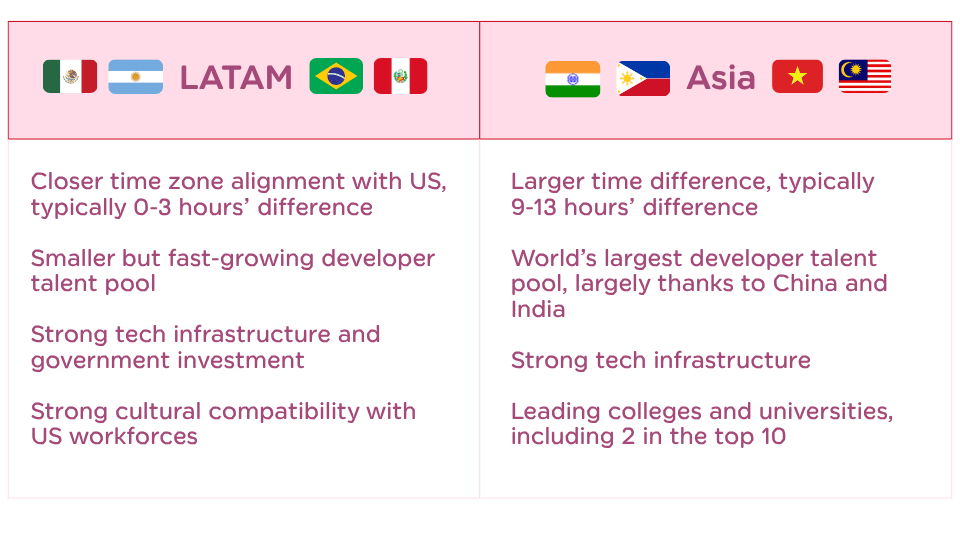Compare the two most popular regions for remote tech hiring.

Remote work has opened up the world, and knowing where to find top-tier professionals can make all the difference when building your global workforce. This article will explore a range of countries across the two most popular regions for remote hiring, Asia and LATAM, breaking down their strengths and drawbacks.

Mexico is quickly becoming a top choice for North American companies looking to outsource. Its close proximity to the US not only makes travel and communication easier but also ensures time zone alignment, making real-time collaboration a breeze. English proficiency is strong, particularly among professionals in major cities, and the country’s educational system produces a steady stream of skilled workers in IT and software development.
Mexico is particularly well-suited for businesses looking for IT support, engineering talent, and bilingual customer service representatives who can cater to North American markets seamlessly.
Brazil, as the largest economy in Latin America, offers a vast and dynamic workforce. The country has a booming tech scene, with hubs like São Paulo and Rio de Janeiro producing talented software developers and UX designers. Brazilian workers are known for their creativity and problem-solving skills, which make them a great fit for innovative projects.
One downside is that, unlike in other LATAM countries, English is not an official language of the country, so companies need to ensure their candidates are proficient in English. Additionally, Brazil’s complex tax system and higher labor costs compared to neighboring countries can pose challenges.
Argentina is renowned for its educated and skilled workforce, with many professionals excelling in software development and IT services. The country has a strong European cultural influence, which makes it easier for Western companies to connect and collaborate with local talent. Argentine workers are highly adaptable, and their problem-solving mindset makes them stand out in competitive industries.
However, the country’s economic instability can lead to fluctuating currency values and pricing uncertainties, which are important to factor in when negotiating long-term contracts.
Overall, Argentina is a top destination for companies seeking high-quality software developers and IT professionals who can work on complex projects with creativity and precision.
Peru is another Latin American country gaining traction for outsourcing. The workforce is hardworking and increasingly bilingual, especially in urban centers like Lima. Peru’s proximity to North America makes it a good choice for roles requiring real-time communication and collaboration.
However, the technical talent pool in Peru is smaller compared to countries like Mexico or Brazil, which can make finding professionals with more specialized skillsets more challenging.
The Philippines has long been a favorite for outsourcing among US companies. The workforce is highly proficient in English, and the country has a strong cultural alignment with Western markets, making communication and collaboration seamless.
One challenge is time zone differences, but many developers in the Philippines are accustomed to working night shifts to align with North American or European time zones.
Malaysia is another Southeast Asian gem for outsourcing. Its workforce is multilingual, with many professionals fluent in English, Malay, Mandarin and Tamil, making it an excellent choice for companies with diverse global teams. Malaysia offers a stable business environment, and its infrastructure supports remote work well.
However, compared to countries like the Philippines or India, labor costs in Malaysia can be slightly higher, and the talent pool, while skilled, can be limited in certain technological niches.
India is a global powerhouse for outsourcing, particularly in IT, software development, and tech support. The country has one of the largest pools of engineers and developers in the world, many of whom are fluent in English and accustomed to working with international clients. India’s cost-effectiveness makes it an attractive choice for companies looking to scale without massive overheads.
However, the time zone difference can pose challenges for real-time collaboration, especially in more junior roles where communication and feedback are key.
Vietnam offers a fast-growing IT sector, with a young remote-first workforce, and a focus on STEM education, making it well-suited for US companies looking to hire developers internationally. While English is not an official language of Vietnam, it is estimated that over half the population are English speakers.
The main downside to hiring in Vietnam is again the time zone difference, which poses issues for communication and teamwork.
Choosing the best country for outsourcing depends on your business’s specific needs, budget, and the roles you’re looking to fill. Latin America stands out for its cultural alignment and time zone compatibility, making it a fantastic choice for US businesses. Mexico, Brazil, and Argentina in particular are strong picks for technical roles. In Asia, India remains the go-to destination for large-scale IT and software development projects.
If you need help with remote hiring, consider using a service like HireDevelopers. HireDevelopers specializes in connecting North American businesses with top-tier global tech talent, streamlining the entire hiring process from start to finish. HireDevelopers handle everything from sourcing candidates to initial vetting, ensuring you only meet highly qualified professionals who align with your business needs.
A work style assessment is a tool designed to show you how a candidate naturally gets things done. It peels back the curtain on the way they communicate, tackle problems, and interact with colleagues in a real-world work setting. It's not about what they know, but about how they operate. Understanding a Candidate's Professional DNA […]

The global talent landscape has shifted. For CTOs and engineering managers, finding top-tier software developers locally is slower, more expensive, and more competitive than ever. Nearshore software development, partnering with expert teams in similar time zones, has emerged not just as a cost-cutting measure, but as a powerful strategic advantage. It offers the perfect blend […]

The classic 9-to-5 developer gig isn't the only game in town anymore. If you're looking for more flexibility, a side income, or even just a foot in the door of the tech industry, software developer part time jobs are a fantastic—and increasingly common—path forward. The Growing Reality of Part Time Software Development Let's be real: […]
